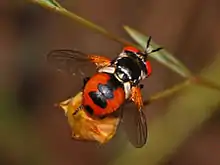Gymnosoma clavatum
Gymnosoma clavatum is a species of tachinid flies in the genus Gymnosoma of the family Tachinidae.[3]
| Gymnosoma clavatum | |
|---|---|
 | |
| Female of Gymnosoma clavatum | |
| Scientific classification | |
| Domain: | Eukaryota |
| Kingdom: | Animalia |
| Phylum: | Arthropoda |
| Class: | Insecta |
| Order: | Diptera |
| Family: | Tachinidae |
| Tribe: | Gymnosomatini |
| Genus: | Gymnosoma |
| Species: | G. clavatum |
| Binomial name | |
| Gymnosoma clavatum Rohdendorf, 1947[1] | |
| Synonyms | |
| |
Distribution
Turkmenistan, Uzbekistan, China, Belarus, Czech Republic, Estonia, Hungary, Lithuania, Moldova, Poland, Romania, Slovakia, Ukraine, Denmark, Finland, Norway, Sweden, Albania, Andorra, Bulgaria, Corsica, Croatia, Cyprus, Greece, Italy, Macedonia, Portugal, Serbia, Slovenia, Spain, Turkey, Austria, Belgium, Channel Islands, France, Germany, Netherlands, Switzerland, Iran, Israel, Canary Islands, Russia, Azerbaijan.
It is not present in the United Kingdom.[3]
Description
.JPG.webp)
Gymnosoma clavatum can reach a length of 6–8 millimetres (0.24–0.31 in). These flies have a black thorax, but males have a mesonotum with golden pruinosity up to the transverse suture. Scutellum is black with two pairs of marginal setae and a quite characteristic red sub-globular abdomen, without setae but with large black markings in the middle. In the females thorax before the scutellum has three spots of dusting. Abdominal tergites are completely fused. The compound eyes are red. Antennae are black. Wings are slightly darkened, with yellow basicostae. Femora and tibiae are black.[4][5]
Biology
Adults can be found from May to October. These flies are endoparasites of various Pentatomidae species, on which the females lay their eggs. Larvae will develop inside them. Known larval hosts of these parasitic flies are Ancyrosoma leucogrammes, Carpocoris pudicus, Cydnus aterrimus, Dolycoris baccarum, Eurygaster integriceps, Nezara viridula, Palomena prasina, Piezodorus lituratus.[6]
References
- Rohdendorf, B.B. (1947). A short guide for determining the dipterous parasites of the noxious little turtle and other pentatomid bugs. Pp. 75–88. In: Fedotov, D.M., ed. Part 2 (in Russian). Moscow- Leningrad: Vrednaya cherepashka. pp. 270 pp.
- Mesnil, L.P. (1952). "Notes détachées sur quelques tachinaires paléarctiques". Bulletin et Annales de la Société Entomologique de Belgique. 88: 149–158.
- O’Hara, James E.; Henderson, Shannon J.; Wood, D. Monty (5 March 2020). "Preliminary Checklist of the Tachinidae (Diptera) of the World" (PDF). Tachinidae Resources. Retrieved 21 August 2023.
- Cerretti, Tschorsnig, Lopresti, Di Giovanni Mosch interactive key ZooKeys 205: 5–18. doi: 10.3897/zookeys.205.3409
- George C. Steyskal – Keys to The Insects of The European Part of The USSR – Vol. V
- Rider, David A. "Diptera Parasitoid Records, List by Host Species". Fargo, North Dakota: North Dakota State University, Department of Entomology. Archived from the original on 9 July 2008. Retrieved 9 October 2009.